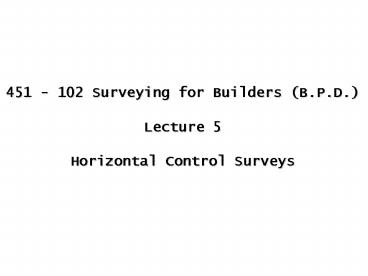Department of Geomatics - PowerPoint PPT Presentation
1 / 35
Title:
Department of Geomatics
Description:
Resection. Traversing. The process of locating and co-ordinating a point from at least two existing ... Resection ... Resection example ... – PowerPoint PPT presentation
Number of Views:662
Avg rating:3.0/5.0
Title: Department of Geomatics
1
451 - 102 Surveying for Builders
(B.P.D.) Lecture 5 Horizontal Control Surveys
2
Methods of establishing horizontal control
- Intersection
- Resection
- Traversing
3
Intersection
The process of locating and co-ordinating a point
from at least two existing control stations by
observing horizontal directions at the control
points
- Calculate the bearing and distance from the known
coordinates - Using the sine rule deduce the other lengths of
the triangle formed by the two known control and
unknown point - Establish the bearings to the unknown points from
the known points - Calculate the coordinates of the unknown points
using the bearings and distances computed.
4
N
C
b
a
B
A
Hint Always draw a diagram
5
Intersection example
A new control point P is to be established from
existing coordinated points A and B. The
horizontal clockwise angles at A and B have been
observed as PBA 44o 52' 36" and BAP 284o 26'
38" respectively. Calculate the coordinates of
the Station P given that the coordinates of A are
3931.82mE, 7491.98m N and of B are 2959.39m E,
7487.09m N.
6
Step 1 Draw Diagram
7
Step 2 Compute bearing and distance between A
and B using known coordinates
8
Step 3 Compute angles in the triangle formed
9
Step 4 Using the sine rule compute distances in
the triangle.
10
Step 4 Compute bearing of lines to unknown
point.
11
Step 5 Compute coordinates of unknown point.
12
Step 5 Check coordinates computed using other
known point
13
(No Transcript)
14
Resection
Determining the position of a point by observing
horizontal directions from it to at least three
points of known position.
- Depending upon the disposition of control points,
the unknown point can lie either inside or
outside the triangle formed by the control
points. - Calculate the coordinates of the unknown point
using Tienstra's formula.
15
A
g
B
b
a
P
C
16
Resection example
Angles have been observed at station P between
the coordinated control points A, B and C so that
the position of the station can be determined by
resection. Calculate the co-ordinates of P,
given Coordinates A 2876.24mE 8754.11mN
B 3810.80 7997.25 C
2959.39 7487.09
a 82.47056 b 140.9808 g 136.54864
17
Step 1 Draw Diagram
A
A
g
b
B
B
a
P
C
C
18
Step 2a Compute bearing between A and C using
known coordinates
19
Step 2b Compute bearing between A and B using
known coordinates
20
Step 2c Compute bearing between B and C using
known coordinates
21
Step 3 Compute angles in the triangle formed
A
g
b
B
B
a
P
C
C
22
Step 4 Compute coordinates of unknown point.
23
Traversing
Rectangular co-ordinates determined from a
combination of of angle and distance measurements
along lines joining adjacent stations
X
2
Y
1
3
Closed link traverse
3
Closed loop traverse
X
2
1
24
Traversing Fieldwork - Reconnaissance
- Locate suitable stations for traverse stations
- number of stations kept to a minimum
- lengths of line as long as possible
- stations should be intervisible,
- stations should be on firm, level ground
- traverse line of sights should be well above the
ground - station diagrams
25
Station Marking
- Station markers must be
- permanent
- not easily disturbed
- should be clearly visible
- wooden pegs, nails, pipes, concrete
- reference or witnessing sketch
building
N
Fence post
3.4m
3.8m
3.6m
Iron bar set in concrete
Manhole cover
26
Traversing Fieldwork Angular Measurement
- Forced centring - three tripod traversing
- centring errors are more significant on short
lines
27
Errors in Angular Measurement
- Inaccurate centring of theodolite or target
- non verticality of target
- inaccurate bisection of target
- parallax not eliminated
- refraction, wind and atmospheric effects
- theodolite not level and not in adjustment
- incorrect use of the theodolite
- mistakes in reading and booking
28
Traversing Fieldwork Distance Measurement
- Measured using EDM or steel taping
- distance and angle measurements made
simultaneously with total station
29
(No Transcript)
30
Angular Misclosure
Sum of internal angles (2n -4) x 90o Sum of
external angles (2n 4) x 90o
For a link traverse Sum of angles (final
forward bearing - initial back bearing)
m x 180o
An allowable misclosure is divided equally
between the observed angles
31
(No Transcript)
32
Bearing Calculation
33
Computation of Co-ordinate Difference
34
Misclosures
35
Calculation of the Final Co-ordinates































